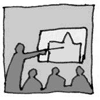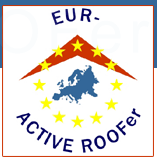|
WORK PACKAGES
WP A- New Concepts for Active Roofs
WP B - Wind and Seismic Effects
WP C - Rain and Wind Driven Rain Effects
WP D - Condensation
WP E - Snow and Ice Load
WP F - Safety in Installation, Maintenance and Repair
WP G - Guidance
WP H - Pre-standardisation
WP I - Training activities
The work in EUR-ACTIVE ROOFer is divided in nine
so-called Work Packages, numbered A to I. This section describes what
will be done in each of these Work Packages.
| WP A- New Concepts
for Active Roofs |
 |
In work package A integrated solutions will be developed
for Active Roofs, including parameterisation and characterisation of solar
energy systems, aspects of functional use and comfort of spaces under roofs,
illumination, ventilation and safety. To effectively evaluate both existing
and newly developed solutions and to shape the training programmes of this
project, a central database including all developed solutions will be developed.
Architectural aspects of the solutions will also be considered. WP A will
bring together experts in all aspects of roofing to develop practical and
innovative integrated Active Roof solutions (leader: Cenergia).
| WP B - Wind and
Seismic Effects |
 |
Non-traditional roof elements can be much more
sensitive to wind and seismic loading than traditional products such as
roofing tiles and can easily be blown off the roof or be damaged during
earthquakes. Wind loading can be particularly sensitive to small changes
in the form of a roof caused by Active Roof elements particularly where
accessories, such as PV panels are mounted above the roof. There is currently
no guidance available on these effects so research will be carried out
into seismic effects on roof accessories, permeability, pressure equalizing,
the position of the roof accessory on or in the building envelope, the
duration of the wind load, the effect on wind pressure shape factors for
various mounting methods and the possibility of the roof accessory increasing
the wind loads on the existing roof structure (leader: TNO).
| WP C - Rain and
Wind Driven Rain Effects |
 |
Any non-traditional roof elements or accessories
will be a potential source of leakage due to penetrations through the
roof or at interfaces with the existing roof elements. On Active Roofs
there will be many interfaces and penetrations through the waterproof
roof envelope from ventilation devices, Photovoltaic systems, etc., which
influence the performance of the roof and create leakages in many cases.
Research will be carried out on the performance of Active Roofs under
rain and wind driven rain and the causes of leakage such as capillary
action, wind blown rain, flooding or overtopping of drainage channels,
etc. Experimental and/or theoretical assessment procedures will be developed
(leader: BRE).
| WP D - Condensation |
 |
Various solutions for Active Roofs where a vapour
tight outside layer is applied or where the roof element constitutes a
highly vapour tight layer lead to problems under this layer. Warm, moist
air under the layer will condense and consequently water is left in the
roof structure, leading to the undermining of wooden structures and corrosion
of metal parts. The use of very vapour tight materials like Photovoltaic
systems is rather new and the existing knowledge in the roofing trade
is not sufficient to design these and other Active Roof systems to adequately
take the condensation risk into account. Research will be carried out
to develop suitable methods for simulation of climatic impact related
to condensation and the problems of moisture and humidity induced ageing.
Theoretical models for the negative effects of water trapped in the insulation
and wood of the roof construction will be developed and validated by experiments
and practical applications (leader: BTI).
| WP E - Snow and
Ice Load |
 |
Active Roofs can be more sensitive to snow load
and consequently increase the risk of damage. This work package will focus
on several different roof coverings and installations used in Active Roofs.
Snow and ice friction will be of special interest because this involves
important safety issues such as snow avalanches from roofs caused by the
low friction of, for example, Photovoltaic systems. Research into these
and other related issues such as freeze-thaw cycles will be carried out
leading to theoretical models and experimental testing (leader: NBI).
| WP F - Safety in
Installation, Maintenance and Repair |
 |
The majority of roof installation, maintenance and
repair is carried out without built-in safety devices. EU demands for
improved safety of workers on roofs require more accessible areas on the
roofs. This will lead to new elements on the roofs such as safety hooks,
ladders, walkways, etc. This WP will focus on providing innovative solutions
and practical guidance for the use of these fixed or mobile devices and
their integration into Active Roofs. Many of these safety devices could
affect the function of the roof leading to for example wind damage, rain
penetration or snow drift (leader: EMI).
As a result of the WPs B to F, both guidance tools and prestandardisation
documents will be developed. This part of the project concerns the development
of practical guidance for the roofer and the preparation of pre-standards.
| WP G - Guidance |
 |
This WP will carry out a critical review of the
results of WPs B-F and will develop simplified rules for design of Active
Roofs, taking into account different climatic zones and different roof
constructions in the member states. A catalogue of best practice examples
will also be produced (leader: IFD).
| WP H - Pre-standardization |
 |
This WP will prepare pre-standards for wind loading,
seismic effects, driving rain, condensation and snow and ice loading for
consideration by the appropriate CEN or EOTA committees. This work will
accumulate in a set-up for labels on Active Roofs and Active Roofers,
published and stimulated by the IFD (leader: TNO).
| WP I - Training
activities |
 |
WP I deals with all aspects of training. The training
activities will be carried out on two levels: first training programmes
will be developed by trainers who work for the training schools of the
national roofing associations. They will be available in electronic form
such as DVDs, in English, German and French. Then, the national associations
will be responsible for adapting these for the country/region training
roofers in their national language (leader: ZVDH).

·
|


